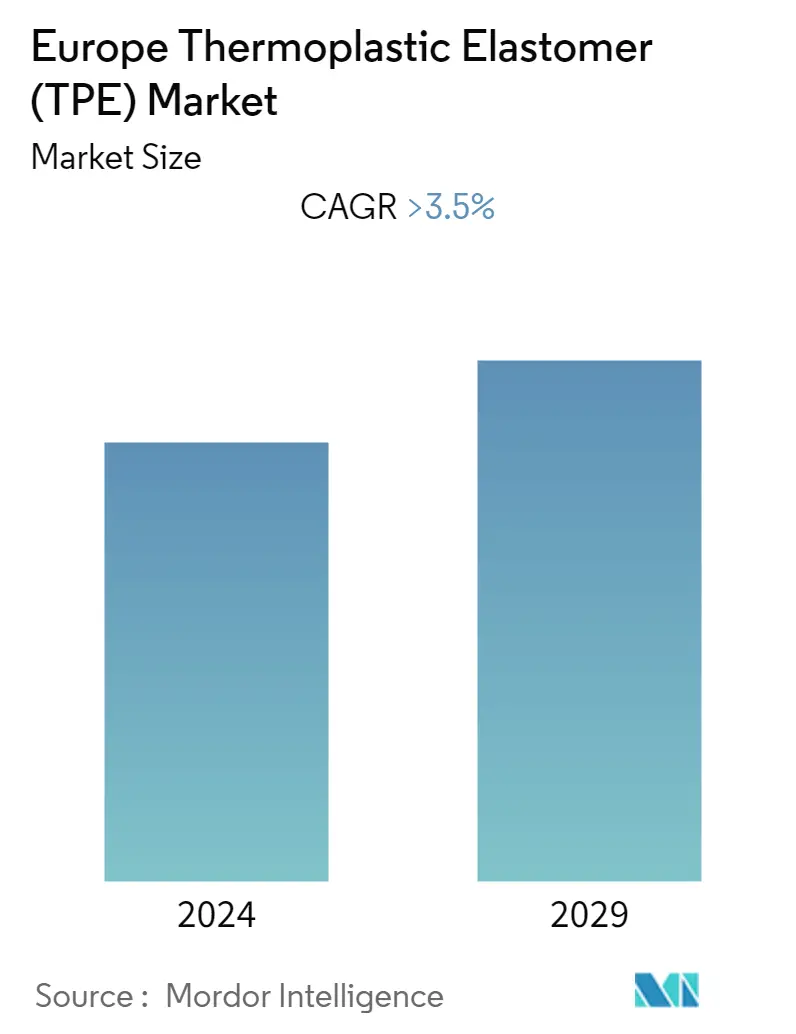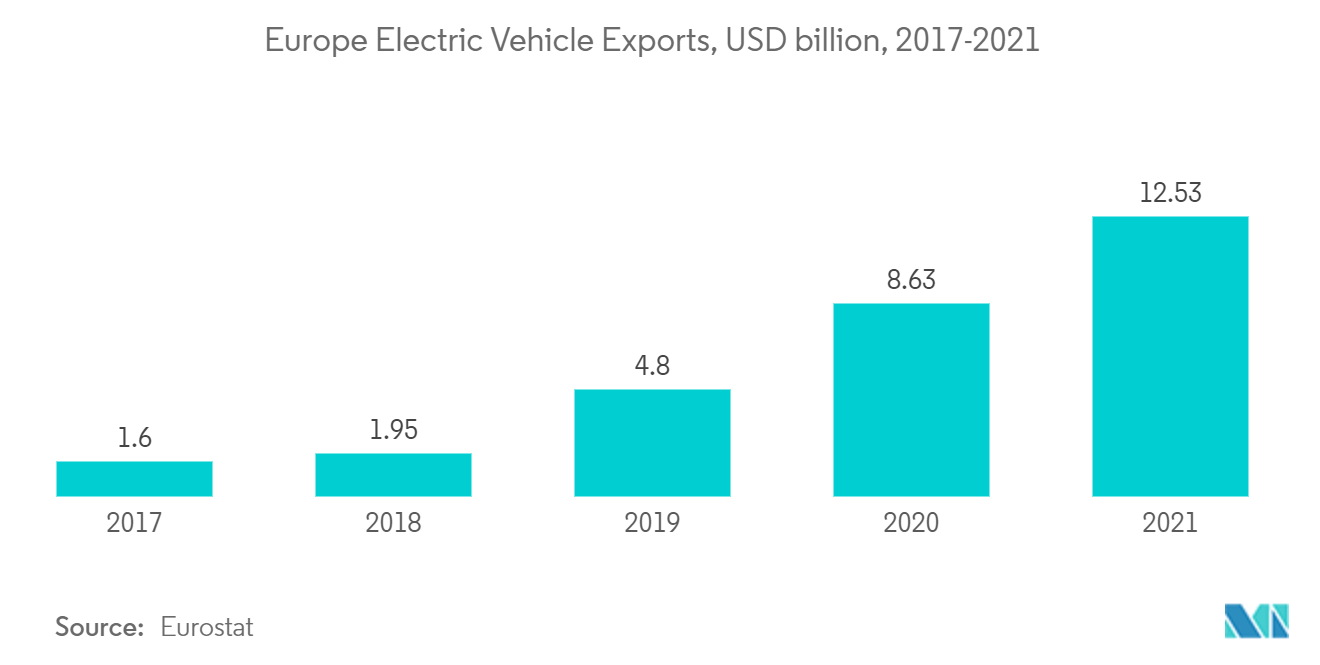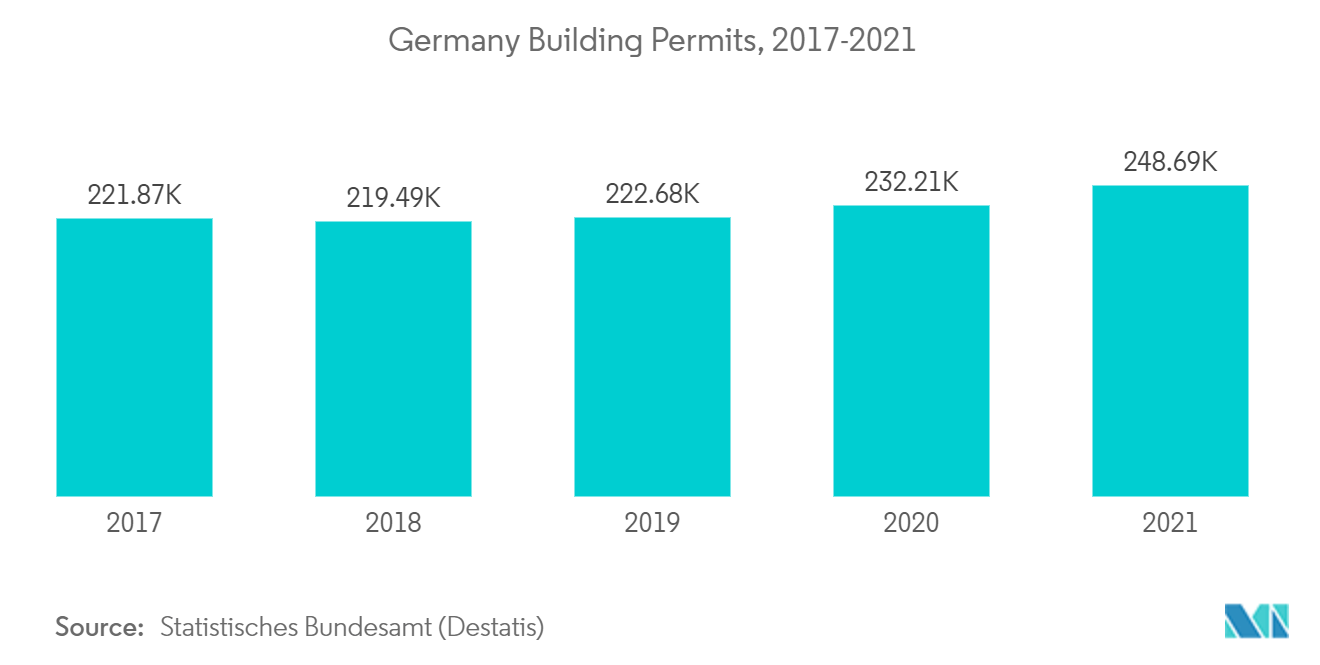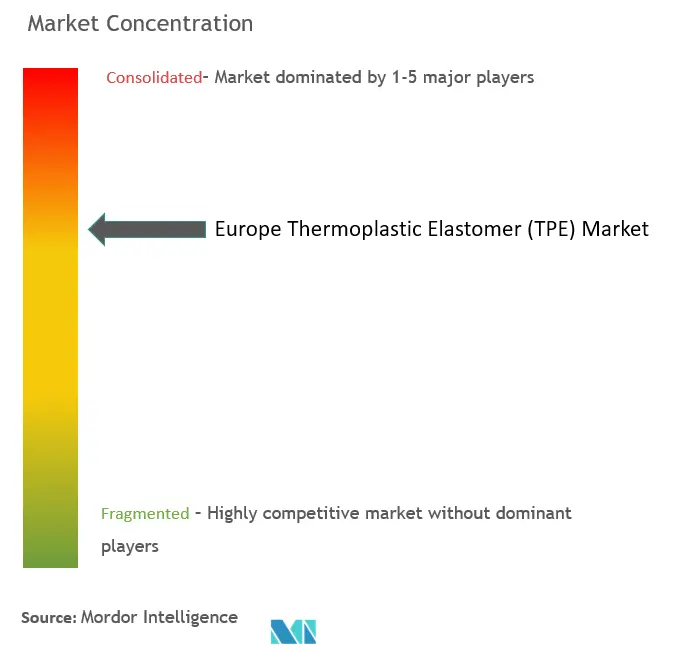Europe Thermoplastic Elastomers Market Size

| Study Period | 2019 - 2029 |
| Base Year For Estimation | 2023 |
| Forecast Data Period | 2024 - 2029 |
| Historical Data Period | 2019 - 2022 |
| CAGR | 3.50 % |
| Market Concentration | High |
Major Players_Market.webp)
*Disclaimer: Major Players sorted in no particular order |
Europe Thermoplastic Elastomers Market Analysis
The European thermoplastic elastomer (TPE) market is projected to register a CAGR of over 3.5% during the forecast period.
In 2020, COVID-19 affected the market. The European thermoplastic elastomer market suffered from declining automotive industries and the government-imposed lockdown, which halted construction and automotive manufacturing. Thermoplastic elastomers make gaskets, plastics, pipes, coatings, belts, and hoses. However, the market recovered in 2021 with the demand for gowns, drapes, gloves, and other thermoplastic elastomer-based medical items.
- Over the short term, the increasing demand for thermoplastic elastomers in the construction industry materials, like rubber-based tool grips, pipes, plastics, and gaskets, is expected to drive the market's growth.
- However, market saturation in the applications of thermoplastic elastomers is expected to hinder the market's growth in the future.
- The growing demand for bio-based thermoplastic elastomers will likely create opportunities for the market in the coming years.
- Germany is expected to dominate the market and will likely witness the highest CAGR during the forecast period.
Europe Thermoplastic Elastomers Market Trends
This section covers the major market trends shaping the Europe Thermoplastic Elastomer Market according to our research experts:
Increasing Usage in the Automotive and Transportation Applications
- The automotive and electric vehicle sectors utilize thermoplastic elastomers (TPEs) because they combine the manufacturing convenience of thermoplastics with the elasticity and durability of elastomers. Due to their low-temperature flexibility, chemical resistance, toughness, and ability to be molded into complex shapes,
- TPEs are used for sealing, hoses and tubing, cables, interior and exterior components, and many more applications. TPEs are used in EVs for cables, wiring, hoses, tubing, seals, gaskets, and interior and exterior components due to their lightweight, flexibility, and durability in extreme climatic conditions.
- The automotive sector includes very rigorous standards for the materials utilized. Even when subjected to extreme loads, the materials must be dimensionally stable and not distort, even when subjected to wide temperature differences.
- TPEs are plastics that are less expensive than metals and help make automobiles more energy-efficient by lowering weight and providing durability, corrosion resistance, toughness, design flexibility, resiliency, and good performance at a low cost. TPE's reduced weight allows for more fuel-efficient automobiles. It is anticipated that every 10% reduction in vehicle weight results in a 5-7% reduction in fuel consumption.
- The growing demand for lightweight and high-performance polymers in the automotive industry to give better economy and design flexibility is driving the TPE market's rise. High-performance thermoplastic elastomers provide manufacturers with design advantages and equivalent strength to steel, which aids in weight reduction and greenhouse gas emissions control.
- The European automotive sector is a key segment of the worldwide automotive industry and a substantial contributor to the European economy. The sector is distinguished by a long history of engineering and invention, a highly skilled workforce, and a big automotive market. In 2021, Europe's automobile sector was worth more than USD 75 billion.
- In recent years, Europe is a major player in the global electric vehicle market, with nations such as Germany, France, and Norway leading the way in EV adoption and production. According to Eurostat, Europe's electric car exports in 2021 reached USD 12.53 billion, a 45% increase over the previous year.
- All the abovementioned factors are expected to augment the demand for thermoplastic elastomers in the region over the coming years.

Germany to Dominate the Market
- TPE (thermoplastic elastomer) is a type of polymer material utilized in the aerospace industry due to its elasticity, durability, flexibility, and resistance to temperature, chemicals, and UV light. TPEs are used in various airplane applications, such as sealing and cushioning, hoses and tubing, and electrical and engine components.
- TPE offers a versatile material with a combination of physical qualities and processing simplicity, making it suitable for usage in various regions of an airplane. Germany produces more than 6% of the world's automobiles and 12% of the world's aircraft manufacturing, bolstering the region's TPE market.
- Germany includes the largest automobile industry. According to OICA, the country produced 33,08,692 vehicles by the end of 2021. Germany leads the European automotive market, with around 40 assembly and engine production plants contributing to one-third of Europe's total automobile production.
- TPE (thermoplastic elastomer) is employed in the housing industry because of its resilience to temperature, chemicals, and UV radiation. TPEs are widely utilized in flooring, roofing, windows & doors, and bathroom fixtures. They are suitable for house use because they combine durability, flexibility, and ease of upkeep. According to the Federal Statistical Office, building permits in Germany increased by 7% in 2021 to 248,688 permits (Destatis).
- Therefore, the above factors are expected to significantly impact the market in the coming years.

Europe Thermoplastic Elastomers Industry Overview
The European thermoplastic elastomer market is partially consolidated in nature. The key players in the market include DuPont, BASF SE, Covestro AG, KRATON CORPORATION, and SABIC.
Europe Thermoplastic Elastomers Market Leaders
-
DuPont
-
BASF SE
-
Covestro AG
-
KRATON CORPORATION
-
SABIC
*Disclaimer: Major Players sorted in no particular order

Europe Thermoplastic Elastomers Market News
- November 2022: HEXPOL TPE officially launched bio-attributed medicinal TPEs. Increasing their portfolio of materials that enable a transition away from fossil feedstocks. Mass balancing allows for a progressive increase in bio-circular share utilizing existing infrastructure to reduce fossil resource usage gradually. Because the resulting TPE material is a drop-in solution with equivalent qualities, HEXPOL TPE identified mass balance as a promising alternative for their medical customers. It is because renewable monomers have the same quality and purity as those derived from fossil sources.
- October 2021: DuPont launched Liveo Pharma Bottle Closures - one-piece silicone stoppers and tubings manufactured from biomedical-grade silicone elastomers - a welcome addition to the company's existing over-molded assembly offering for biopharma processing applications. Liveo Pharma Bottle Closures are designed to seal the threaded glass, plastic bottles, and containers used in biopharmaceutical and biotechnology processes for essential fluid transfer, media and buffer pooling and storage, and sample collecting.
Europe Thermoplastic Elastomers Market Report - Table of Contents
1. INTRODUCTION
- 1.1 Study Assumptions
- 1.2 Scope of the Study
2. RESEARCH METHODOLOGY
3. EXECUTIVE SUMMARY
4. MARKET DYNAMICS
-
4.1 Drivers
- 4.1.1 Growing Demand from the Construction Industry
- 4.1.2 Growing Applications in the HVAC Industry
-
4.2 Restraints
- 4.2.1 Market Saturation in Applications
- 4.2.2 Unfavorable Conditions Arising due to the Impact of COVID-19
- 4.3 Industry Value Chain Analysis
-
4.4 Porter's Five Forces Analysis
- 4.4.1 Bargaining Power of Suppliers
- 4.4.2 Bargaining Power of Consumers
- 4.4.3 Threat of New Entrants
- 4.4.4 Threat of Substitute Products and Services
- 4.4.5 Degree of Competition
5. MARKET SEGMENTATION
-
5.1 Product Type
- 5.1.1 Styrenic Block Copolymer (TPE-S)
- 5.1.2 Thermoplastic Olefin (TPE-O)
- 5.1.3 Elastomeric Alloy (TPE-V or TPV)
- 5.1.4 Thermoplastic Polyurethane (TPU)
- 5.1.5 Thermoplastic Copolyester
- 5.1.6 Thermoplastic Polyamide
-
5.2 Application
- 5.2.1 Automotive and Transportation
- 5.2.2 Building and Construction
- 5.2.3 Footwear
- 5.2.4 Electrical and Electronics
- 5.2.5 Medical
- 5.2.6 Household Appliances
- 5.2.7 HVAC
- 5.2.8 Adhesives, Sealants, and Coatings
- 5.2.9 Other Applications
-
5.3 Geography
- 5.3.1 Germany
- 5.3.2 United Kingdom
- 5.3.3 Italy
- 5.3.4 France
- 5.3.5 Spain
- 5.3.6 Rest of Europe
6. COMPETITIVE LANDSCAPE
- 6.1 Mergers and Acquisitions, Joint Ventures, Collaborations, and Agreements
- 6.2 Market Share (%)**/Ranking Analysis
- 6.3 Strategies Adopted by Leading Players
-
6.4 Company Profiles
- 6.4.1 Apar Industries Ltd
- 6.4.2 Arkema
- 6.4.3 Asahi Kasei Corporation
- 6.4.4 BASF SE
- 6.4.5 Covestro AG
- 6.4.6 DSM
- 6.4.7 DuPont
- 6.4.8 Evonik Industries AG
- 6.4.9 Exxon Mobil Corporation
- 6.4.10 Grupo Dynasol
- 6.4.11 Huntsman International LLC
- 6.4.12 KRATON CORPORATION
- 6.4.13 KURARAY CO. LTD
- 6.4.14 LANXESS
- 6.4.15 LG Chem
- 6.4.16 LyondellBasell Industries Holdings BV
- 6.4.17 Mitsubishi Chemical Corporation
- 6.4.18 Mitsui Chemicals Inc.
- 6.4.19 SABIC
- 6.4.20 Sirmax SpA
- 6.4.21 Sumitomo Chemicals Co. Ltd
- 6.4.22 The Lubrizol Corporation
- *List Not Exhaustive
7. MARKET OPPORTUNITIES AND FUTURE TRENDS
- 7.1 Growing Demand for Bio-based Thermoplastic Elastomers
- 7.2 Increasing Applications in the Medical Industry
Europe Thermoplastic Elastomers Industry Segmentation
Thermoplastic elastomers (TPEs) are elastic materials that possess elasticity similar to cross-linked rubber and find their major applications in end-user industries, such as construction, automotive, and electronics. It is mainly produced from mechanical blending and dynamically vulcanized blending.
The European thermoplastic elastomer (TPE) market is segmented by product type, application, and geography. By product type, the market is segmented into styrenic block copolymer, thermoplastic olefin, elastomeric alloy, thermoplastic polyurethane, thermoplastic copolyester, and thermoplastic polyamide. By application, the market is segmented into automotive and transportation, building and construction, footwear, electrical and electronics, medical, household appliances, HVAC, adhesive, sealant and coating, and other applications. The report also covers the market size and forecasts for the thermoplastic elastomer (TPE) market in five countries across the European region. For each segment, the market sizing and forecasts have been done based on revenue (USD million).
| Product Type | Styrenic Block Copolymer (TPE-S) |
| Thermoplastic Olefin (TPE-O) | |
| Elastomeric Alloy (TPE-V or TPV) | |
| Thermoplastic Polyurethane (TPU) | |
| Thermoplastic Copolyester | |
| Thermoplastic Polyamide | |
| Application | Automotive and Transportation |
| Building and Construction | |
| Footwear | |
| Electrical and Electronics | |
| Medical | |
| Household Appliances | |
| HVAC | |
| Adhesives, Sealants, and Coatings | |
| Other Applications | |
| Geography | Germany |
| United Kingdom | |
| Italy | |
| France | |
| Spain | |
| Rest of Europe |
Europe Thermoplastic Elastomers Market Research FAQs
What is the current Europe Thermoplastic Elastomer (TPE) Market size?
The Europe Thermoplastic Elastomer (TPE) Market is projected to register a CAGR of greater than 3.5% during the forecast period (2024-2029)
Who are the key players in Europe Thermoplastic Elastomer (TPE) Market?
DuPont, BASF SE, Covestro AG, KRATON CORPORATION and SABIC are the major companies operating in the Europe Thermoplastic Elastomer (TPE) Market.
What years does this Europe Thermoplastic Elastomer (TPE) Market cover?
The report covers the Europe Thermoplastic Elastomer (TPE) Market historical market size for years: 2019, 2020, 2021, 2022 and 2023. The report also forecasts the Europe Thermoplastic Elastomer (TPE) Market size for years: 2024, 2025, 2026, 2027, 2028 and 2029.
Europe TPE Industry Report
Statistics for the 2024 Europe TPE market share, size and revenue growth rate, created by Mordor Intelligence™ Industry Reports. Europe TPE analysis includes a market forecast outlook 2029 and historical overview. Get a sample of this industry analysis as a free report PDF download.



